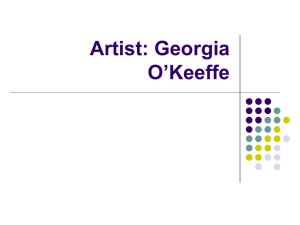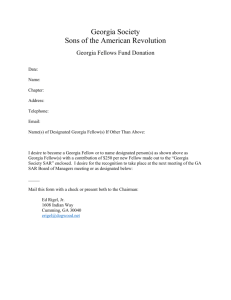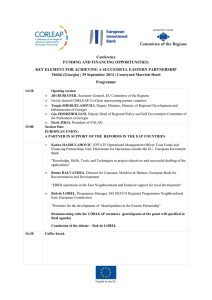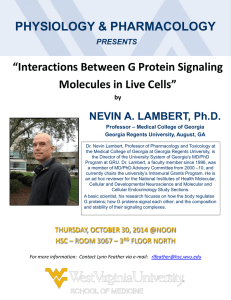Coastal plains of georgia
advertisement
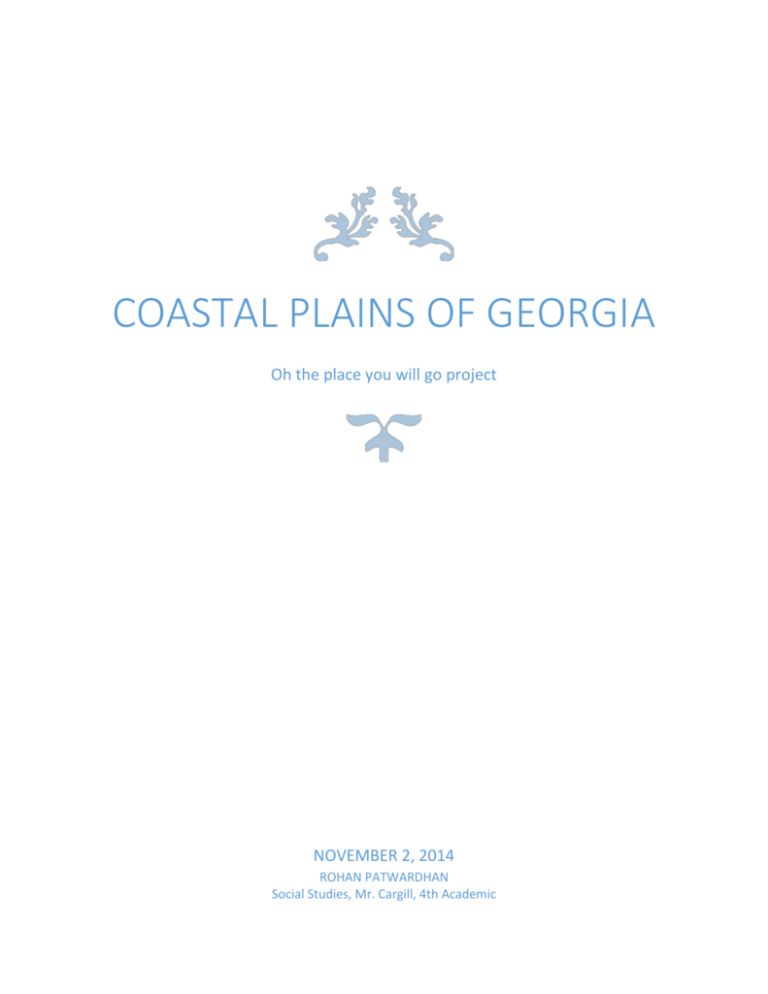
COASTAL PLAINS OF GEORGIA Oh the place you will go project NOVEMBER 2, 2014 ROHAN PATWARDHAN Social Studies, Mr. Cargill, 4th Academic The Coastal Plains is the biggest region in Georgia, taking up the entire bottom half of the state. POINTS OF INTEREST Tubman African-American Museum: This museum is located in Macon. It started in 1981. It displays various arts, history, and culture of the African Americans. It offers many classes based on the African American Culture like dance, drama, drumming, photography, and visual art. Historic Cotton Exchange Center: The Historic Cotton Exchange Center of Augusta, Georgia, USA. It was designed by Enoch William Brown. It was built during the cotton era in the South and used for cotton trade. Morris Museum of Art: It is located on the Riverwalk in Augusta, Georgia, It was named after William S. Morris III. There are many exhibitions, programs, music programs, etc. The Georgia Sports Hall of Fame: The Georgia Sports Hall of Fame, is located in Macon, Georgia. It has over 3,000 artifacts. It honors more than 300 inductees. The Georgia Music Hall of Fame: The Georgia Music Hall of Fame is located in Macon, Georgia. It has a lot of programs that show the music of Georgia through many collections, exhibitions, etc. Tybee Island: You can even visit Tybee Island, which is 20 miles to east of Savannah. Located in Chatham County, it has a lot of beaches, and there are a lot of endangered birds, sea turtles, and salt marshes that take refuge here. 1 Roundhouse Railroad Museum: It is the oldest and largest railroad operation from the 19th century located in Savannah. It was constructed in 1850. You can see the steam and diesel locomotives, the different rail cars, the machinery, models, and the smokestacks. Old Fort Jackson: It is located on the Savannah River and was used extensively during the War of 1812. It has a moat, drawbridge, barracks, and privies. The fort was named after James Jackson, who was from Britain. This fort was also used during the Civil War by the Confederates. This fort was also named Fort Oglethorpe form 1884 to 1905. The Macon Museum of Arts and Sciences: The Macon Museum of Arts and Sciences is all located in Macon, Georgia. It has a planetarium, observatory, nature trails, gardens, and you can see a variety of mammals, reptiles, and birds. Fort Pulaski: It is located on Cockspur Island in Chatham County. In the Civil War, it was a prisoner of war camp. Fort Pulaski was named after Polish general Count Casimir Pulaski, who gave his life for the Patriots in the Revolutionary War in the Siege of Savannah which was ultimately won by the British. It was captured by Union forces after 30 hours of fighting. The battle of Fort Pulaski was from April 11-12 1862. Savannah National Wildlife Refuge: It was created on April 6, 1927. It has 29,175 acres which contains freshwater marshes, tidal rivers and creeks, and bottomland hardwoods. You can hike, bike, hunt and fish at certain times throughout the year. This wildlife refuge is near the border between South Carolina and Georgia. 2 INDUSTRIES Coastal Industry-One of the major industries of the Coastal Plains is the Coastal Industry. In this industry, they market sea foods and wood products. There is a lot of shipping in the ports of Savannah and Augusta. Papermaking- Over time, the paper and pulp industry expanded, and the pollution from the paper mills has resulted in a great suffering for the fishing industry. For every ton of output from a paper mill, 35 million BTU’s of energy are used. More than 3.5 million acres are used for papermaking in the Coastal Plains. Commercial Fishing Industry-The Coastal Plains import and export goods from their ports. The Commercial Fishing Industry thrives due to the Ports in Coastal Plains. However the industry has suffered due to the pollution from Paper Mills around the area. Farming Industry-The Coastal Plains also has a lot of infertile land that is mostly swampy. This place is called the “Pine Barrens” because nothing but pine trees and brushes grow here. This part is mostly used as a pasture and for growing pine trees, so that you can get timber, pulp, turpentine, and many more products. There are also naval stores. Further inland, there is a rise in elevation, where the soil is well drained, and it contains sand, clay, etc. This place in the Coastal Plains Region is very fertile, and it is very famous for the Georgia peaches, Georgia peanuts, Georgia pecans, corn and the Vidalia Onions. The Vidalia onions can only be grown in the Coastal Plains and nowhere else in the entire world. 3 NATURAL RESOURCES The Coastal Plains of Georgia has 4 major natural resources. They are forestry and timber, rocks and sediments, fuel resources, and minerals. Forestry & Timber-The Coastal Plains have pine and hardwood forests of all kinds of trees: white oaks, red oaks, tulipwood, soft maple, hickory, southern yellow pine, maple, black walnut, and bald cypress. The wood of the Bald Cypress Tree doesn’t decay, and it is most commonly used for building, boat planking, making fence posts, and finish carpentry and cabinets. Rocks and Sediments-Clay, Peat, Rocks and Sediment, and Limestone are in Coastal Plains. The main types of clay found in the Coastal Plains of Georgia are: Clay: It is used to make bricks. South Carolina and Georgia lead the nation of North America in the production of clay. Kaolin: China Clay deposits are found on the northeastern, southwestern side, and central region. Fine porcelain, for instance is made up of Kaolin or China Clay. Fullers Earth: It is very absorbent and is also found in this region. Ball clay: It is used to make ceramics. Peat is also produced because of the thick marshes in the Coastal Plains. Peat is used in potting soil, insulation for fruits and vegetables when they are in a package, a protein additive to the cattle’s food, and it is also a soil conditioner. Sedimentary rock deposits are found in this region. Sand and Gravel deposits lay along riverbeds and streams which dot the entire region. All of the clay, sand and gravel resources are being mined using 2 main mining operations in Georgia; One along the Northeastern border of this region, and the second one in the southwest part of this region. Limestone is a sedimentary bedrock, and it is used in construction. Limestone is mined, and then it is mixed with cement to fill the roads. Northern Parts of the Coastal Plain have industrial sand, industrial gravel, shale, cement plant, and crushed stone. 4 Fuel Resources-The Coastal Plains (which is on the Gulf Coast), has a lot of oil and natural gas deposits. It has major natural gas resources in a Mesozoic basin underneath the Coastal Plains. Minerals and Clay-You can find an abundance of mineral and metal ores such as gypsium, bauxite, phosphate, bentonite, mica, titanium, zirconium, perlite, and vermiculite. Reasons for recommending this region I chose to recommend the Coastal Plains of Georgia because it is a very diverse region. First of all, there are many habitats, and it is tourist friendly, because there are over 20 different attractions. Also, many foods that we know of come from this region, such as the Vidalia Onions, peanuts, peaches, etc. It is also an ideal vacation spot for outdoor activities, such as nature trails, hiking, and biking. There are many museums so you can learn of the colorful history of this region. Since it was once the sea floor of Georgia, there will be a variety of marine life and there will be plenty of minerals available here. You can enjoy wildlife centers, historical attractions, and museums. Have a great family vacation along its beaches and waterfronts. Enjoy the southern hospitality through plenty of restaurants in the Coastal Plains. 5 BIBLIOGRAPHY "Antebellum Architecture." Wikipedia. Wikimedia Foundation, 18 Sept. 2014. Web. 05 Oct. 2014. "Tubman African American Museum." New Georgia Encyclopedia. N.p., n.d. Web. 05 Oct. 2014. "Cannonball House (Macon, Georgia)." Wikipedia. Wikimedia Foundation, 22 Sept. 2014. Web. 05 Oct. 2014. United States. National Park Service. "Augusta Cotton Exchange." National Parks Service. U.S. Department of the Interior, n.d. Web. 05 Oct. 2014. Seabrook, Charles. "Lower Coastal Plain and Coastal Islands." New Georgia Encyclopedia. 20 August 2013. Web. 05 October 2014. "Woodrow Wilson Boyhood Home." Wikipedia. Wikimedia Foundation, 10 Apr. 2014. Web. 05 Oct. 2014. "Boyhood Home of President Woodrow Wilson." Boyhood Home of President Woodrow Wilson - Augusta, Georgia. N.p., n.d. Web. 05 Oct. "Fort James Jackson." Wikipedia. Wikimedia Foundation, 09 Oct. 2014. Web. 05 Oct. 2014. "Old Fort Jackson, Savannah, Georgia." Old Fort Jackson, Savannah, Georgia. N.p., n.d. Web. 05 Oct. 2014. "Fort Pulaski." New Georgia Encyclopedia. N.p., n.d. Web. 05 Oct. 2014. "Battle of Fort Pulaski." Wikipedia. Wikimedia Foundation, 27 Sept. 2014. Web. 05 Oct. 2014. "Okefenokee National Wildlife Refuge." Wikipedia. Wikimedia Foundation, 21 Sept. 2014. Web. 05 Oct. 2014. "Tybee Island, Georgia." Wikipedia. Wikimedia Foundation, 28 Sept. 2014. Web. 05 Oct. 2014. "Oatland Island Wildlife Center." Official Website of the Georgia Department of Economic Development. N.p., n.d. Web. 05 Oct. 2014. "Augusta Attractions." Masters Information - Augusta Attractions. N.p., n.d. Web. 05 Oct. 2014. "Savannah National Wildlife Refuge." Gorp.com. N.p., n.d. Web. 05 Oct. 2014. "Georgia Music Hall of Fame." Wikipedia. Wikimedia Foundation, 10 May 2014. Web. 05 Oct. 2014. "Riverwalk Augusta." Wikipedia. Wikimedia Foundation, 31 Aug. 2014. Web. 05 Oct. 2014. "Morris Museum of Art." Wikipedia. Wikimedia Foundation, 10 Mar. 2014. Web. 05 Oct. 2014. "History." « Museum of Arts and Sciences. N.p., n.d. Web. 04 Oct. 2014. "Georgia Sports Hall of Fame." - NewTown Macon. N.p., n.d. Web. 05 Oct. 2014. "Georgia State Railroad Museum, Savannah." Georgia State Railroad Museum, Savannah. N.p., n.d. Web. 05 Oct. 2014. "Choose Another Topic." Geography. N.p., n.d. Web. 05 Oct. 2014. Carolyn Csanyi. "List of Natural Resources in the Coastal Plains | The Classroom | Synonym." The Classroom. N.p., n.d. Web. 05 Oct. 2014. 6

